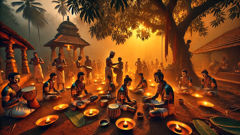Introduction
High in a range of stone-sunk hills where ancient pines gather fog like old stories, a narrow path threaded between stupas and prayer-flagged ridges. The air had that cold sweetness of alpine springs: mineral, moss-dark, and a little like the inside of a bell when it rings. People in the valley spoke of this place with the hush reserved for temples and thunder: a middle place where sky and rock kept counsel, where pilgrims came when their ordinary names for things no longer fit. Mei, a woman who had traveled from a lowland town troubled by grief and the small failures of daily love, arrived with a bundle of incense and a map drawn in a monk's tidy hand. She was not a scholar of scriptures nor a master of ritual; she had come because her nights felt hollow and because an old woman had told her, very simply, that the mind sometimes needs to meet its own friends in a different shape. Legends here said that the Five Dhyani Buddhas—celestial archetypes of awakened mind known in the Tibetan tradition—appeared not as distant deities but as living qualities within the world if one had the patience to see. They took form like petals opening into a mandala: Vairocana, shining with the clarity of white space; Akshobhya, mirror-calm in blue; Ratnasambhava, golden as ripe grain; Amitabha, crimson with the hush of limitless light; and Amoghasiddhi, green and quick as wind-swept bamboo. The people of the hills worshipped these names and, more quietly, used them to teach attention: to breathe into suffering like a soft bell, to rest a mind's loudness on a single color, to keep a quiet vigil that reshaped how a life could be felt. Mei's entrance to the high place was like stepping across a threshold in a painting: one foot left the world she knew; the other moved toward a possibility whose borders shimmered. She walked so the story could unfold—not as a scholar writing notes, not as a pilgrim carrying conviction, but as someone willing to be rearranged by what she would meet.
Meeting the Luminaries: The Pilgrim and the Five Faces of Mind
Mei's first days at the mountain temple were given to listening. She sat on boards warmed by the sun and watched old monks arrange sand and lay down rice and pigments in patterns that seemed to appear out of patient waiting. The elder who had taken her in—a robed man with a hairline scar along his jaw and the gentle nod of someone who had learned to hear the silence between words—told her, in the easy manner of a teacher who trusted curiosity more than doctrine, that each of the Dhyani Buddhas is a compass point within a mandala of mind. "They are not gods who live somewhere else," he said. "They are ways of waking. Meet them like neighbors." That first evening the temple chimed a bell until the air shivered. Smoke from incense pooled like soft clouds and the five images on the altar glowed: Vairocana at the center, Akshobhya to the east, Ratnasambhava to the south, Amitabha in the west, and Amoghasiddhi to the north. Mei had seen painted images before but now the colors seemed to carry a temperature—a clarity you could feel pressing against the inside of your chest. Vairocana's white included every subtle shade of light. His face was open, as if someone had swept a curtain away from a window and invited the mind to look. The elder guided Mei to begin with breath. "Wind and belly. Breathe as if you're letting the room become your own body." She learned a simple visualization: inhaling, she pictured a white sphere in the center of her head; exhaling, she let it expand, washing a quiet brightness through the cluttered rooms of her thoughts. When she practiced, noise settled like dust beneath a door. Vairocana's teaching, she felt, was not absence but recognition—bringing undivided attention to what was already luminous. On the second day she was led to the east hall, where a statue of Akshobhya watched with a gaze that never flickered. He was cobalt blue, seated in the earth-like steadiness of unshakable calm. The elder spoke of mirror-like awareness: the mind that reflects without clinging, that lets anger and fear appear like weather on water. Mei thought of the small, bitter arguments at home that had left her cheeks hot and her hands clenched. She practiced seeing those moments as surfaces: ripples moving across a deeper stillness. As she allowed a memory's ache to arise and remain visible without being swallowed by reaction, she felt a concrete steadiness settle under her ribs, like a stone laid in a fast riverbed. Ratnasambhava's warmth arrived like the hush of harvest. In the south shrine he held a golden jewel in one hand and smiled with the softness of someone who has made peace with scarcity. His teaching moved around generosity and the transmutation of pride into noble giving. Mei had carried a quiet ledger of shame—what she had not done, the favors she had failed to return—but Ratnasambhava's presence taught her that giving is both soil and seed: the hand that frees an object also frees the heart that clutches it. She practiced offering small things—her time, her patience—and watched resentment loosen like old thread. When the western light came and the temple bells counted the hour, Amitabha's red mirror glowed. He was the Buddha of boundless light and luminous compassion, a presence that seemed to hold a reservoir of longing and transform it into tenderness. The elder taught a practice of calling loved ones into the light, visualizing each face bathed in crimson clarity, and letting grief be seen not as a wound to hide but as a river to be crossed. As Mei placed each memory into Amitabha's field, something in her chest unclenched. She began to recognize how longing could be a compass toward connection, not only a painful absence. Amoghasiddhi, green and quick as the leaning pines outside the temple window, was the last to enter Mei's practice. His energy was action without attachment: the fearless competence that arises when one acts from integrity rather than impulse. The elder encouraged practical vows: not grand promises that collapse with the first difficulty, but small resolve, tried and true. Mei learned to set a steady aim—daily tasks held with mindful attention—finding that action becomes a form of meditation when the motive is clean. Across days and nights, Mei realized the Dhyani Buddhas were less like a menu of virtues and more like facets of a single jewel. Each buddha's color and posture offered a doorway to an interior capacity waiting to be refined. The mandala the monks drew was not only a painting on earth; it was an invitation for the mind to be rearranged: for thought to become a mirror, for grief to be transformed into compassionate clarity, for pride to soften into generosity, for passion to widen into radiant love, and for doubt to be steadied through purposeful action. There were moments when the world outside pierced the temple: a messenger from the valley, the clatter of a cart, the sudden white of snow on a distant slope. But within the practice, those intrusions settled into the larger pattern. A fox nosed near the outer courtyard one morning and the elder laughed soft as wind. "Even foxes have their Buddhas," he said, as if telling Mei that nothing in the field of experience was excluded from awakening. Over time, these practices altered what Mei noticed. She carried the memory of a white center in the space behind her eyes; she found herself less reactive when an insult arrived; she gave without counting; she mourned with a gentleness that allowed presence; and she acted with steadiness. The temple did not promise miracles. It offered a discipline: the slow retuning of the senses until ordinary events began to reveal sacred geometry. In the quiet between the chanting and the clatter of daily chores, Mei began to sense that the Dhyani Buddhas were both within and without—forms made of light and of habit, of color and of cultivated attention. They did not rescue her from sorrow but taught her to sit with it as one sits with a beloved who is ill. The practice shaped her not into someone else but into a clearer version of herself, and in that sharpening the old world quietly changed shape.

The Mandala's Work: Practices, Symbols, and the Quiet Alchemy of Change
Beyond the immediate intimacy of first encounters, Mei's weeks at the temple became a careful apprenticeship in language without words. The monks taught practices that were both precise and poetic: mantras whose syllables fit the spaces between the ribs, mudras that shaped the flow of intention in a hand's geometry, and visualizations that turned the mind toward different qualities like a careful gardener turning soil. Each Dhyani Buddha had associated attributes—not merely ornaments but pointers to psychological alchemy. Vairocana, white and central, signaled the possibility of seeing without being trapped by stories. The elder explained that white is the light that reveals all colors, and so Vairocana's field invites one to rest in awareness that is luminous but unattached. Mei learned a method of resting attention like a lantern hung in a dark hall: not directed at any object, not searching for something to hold, but simply being the light that allows seeing. In practice, this resembled the quiet moments after tears when the breath is slow and the mind is not yet telling itself how to feel. Akshobhya's mirror-like blue offered the discipline of reflection. The monks taught an exercise in which Mei brought a memory of anger or insult into a wide inner field and let it appear with all its textures. Instead of turning away or gripping, she let the feeling be observed, like a cloud moving across a still lake. The image of a mirror is precise: nothing is held by the mirror, nothing is lost; everything is reflected, returned, and thereby known without distortion. Ratnasambhava's golden field was a pedagogy of generosity and equanimity toward status and value. The monks invited Mei to imagine an inner market where coins of praise and blame clinked against one another. Rather than hoarding praise or counting slights, she practiced placing both into a shared pot of gratitude. This was not denial of injustice but a refusal to trade integrity for petty exchange. Amitabha's crimson compassion involved visualizing a city of light—faces that needed warmth, memory's hurts, a whole geography of longing. The practice asked her to soften her gaze until pain could go from being a secret weight to a shared presence. In doing so she discovered a paradox: the heart that learns to hold suffering also enlarges its capacity for joy. Amoghasiddhi's green vigor trained right action: skillful means that do not seek recognition. The monks taught her to set modest vows—thresholds of practice small enough to keep and true enough to matter. These were practical vows: tend the firewood; mend what is torn; return a borrowed bowl. Such acts, repeated, rewired the impulse toward distraction into an engine of purpose. The mandala itself, constructed each morning, became a living textbook. It was not made once and put away like a dusty scroll; sands and pigments were laid with breath and intention, then patiently dismantled. The act of creation and destruction mirrored the teaching: nothing is fixed, and beauty's temporality is part of its lesson. Mei learned the symbolic geometry: center and periphery, quadrant and cardinal, colors that address the emotions in the stomach, the heart, the mind, and the limbs. The elder showed how offerings—fresh water, tiny blossoms, a sweep of the floor—were less ceremonial than corrective. They were ways of aligning the body with the mind's new pathways. A major turning point came when the elder invited Mei to build her own small mandala. He gave her pigments—white crushed from ground stone, ultramarine made of rare minerals, gold leaf saved for special practice, vermillion mixed with rice paste, and verdant green ground from mountain herbs. "Do not aim for perfection," he warned, smiling. "Let it be truthful." Mei painted slowly, tracing a central white disk, then composing the quarters with blue, gold, red, and green. As she worked, memories surfaced and sank like fish in a pond. She found herself thinking of a sister she had not spoken to in years, of a child who had once laughed in her kitchen, of the slow erosion of small kindnesses into habit. The mandala did not fix these memories; it framed them. In the act of making, Mei practiced an inner rearrangement: what had been a jagged line in her life became a pattern with meaning. The monks' teachings never dissolved the world into abstraction; they always returned practice to the world of daily care. The Dhyani Buddhas' qualities were enacted in how one lit a lamp at dusk, how one carried a bowl of soup, how one listened to a neighbor's grief. Spiritual insight, the elder said, is most trustworthy when it shows in ordinary behavior. Technical instructions accompanied the poetic: how to hold a mala, the cadence of breath in visualization, the precise placement of the thumb in certain mudras. But more than ritual, those details taught discipline. They gave the mind a ritual grammar that could redirect habitual reactivity into deliberate presence. Mei learned to breathe with a color as if it were a companion; she learned to let anger be a mirror; she learned to give and to act without hingeing her value on approval. There were tests, too—not the dramatic trials of myth but the slow kindnesses and small betrayals that show character. A merchant came to the temple to ask a blessing for his wagon; the elder gave him a short, direct counsel and charged a modest fee to support the temple. Mei saw how the temple balanced generosity with survival. Once, a messenger brought news of a daughter taken ill back in Mei's valley. The old, familiar alarm rose like a wave. She wanted to run home. The elder told her to sit and breathe until the wave passed and then to decide with steady heart. She stayed for two more days, then returned with a clarity she had not had before. She traveled with the memory of the white center behind her eyes, with a mirror in her chest, with a practice of soft generosity and a small vow to mend what she could. On the way she performed small actions without drama—helping a woman with a broken cart, sharing a bowl of soup, speaking kindly to a child crying for a lost goat. These acts were the mandala translated into walkable ethics. In the valley, the family's crisis unfolded as many crises do, with moments of meanness and tenderness braided together. Mei found that she approached the situation with a steadier breath and a patient skillfulness. Her sister was proud and resistant, and so Mei did not attempt grand words. She lit lamps, swept floors, and waited; these simple rites, informed by the Buddhas' lessons, began to shift the household's temperature. The green energy of Amoghasiddhi showed up in the practical fixes she made; Amitabha's light was present when she held her niece at night as fever burned. Ratnasambhava's golden generosity allowed her to set aside imagined slights in favor of tending the immediate need. Akshobhya's mirror kept her from being blown off course by bitter remarks; Vairocana's white calm allowed her to sit with grief without being swallowed by it. Over months the household's texture changed, not because a miracle rewired people's hearts but because a small steadiness multiplied. Mei did not become enlightened in a single moment; she was more often simply less flinching, more willing to look, more inclined to act from clarity. The monks' teachings had given her tools—images, vows, mudras, and colors—that were not dogma but instruments. They taught her to treat her inner life like a garden that had to be turned, watered, and pruned. The most radical lesson, one that had nothing to do with exotic ritual and everything to do with moral courage, was the idea that transformation requires tenderness toward the parts of ourselves we would rather hide. The Dhyani Buddhas did not promise that pain would disappear; they taught how to sit with pain until it became a teacher. And that sitting, repeated and honest, reshapes both the heart and the relationships that heart holds. Mei carried these practices forward like a secret lamp: sometimes others noticed and asked where the light had come from; more often they didn't. The monk had been right: the Buddhas were neighbors, quietly altering how a life arranged itself. She realized that the mandala's work was less about attaining an ideal state than about learning a new grammar for living that translated inner clarity into outward compassion and sure action.

Conclusion
Years later, Mei would tell the story differently depending on her audience. To some she described the temple as a school where she learned simple rituals; to others she spoke of an inner architecture that rearranged how she felt alive. But the truth she kept closest was quieter than either version: the Five Dhyani Buddhas had not removed her trouble; they had given her a language and a set of practices that allowed trouble to do its own work without taking over her life. The white center of Vairocana taught her to open without losing shape. Akshobhya's mirror taught her to reflect without being consumed. Ratnasambhava showed how giving softens the bareness of the heart. Amitabha taught that compassion could hold both grief and joy at once. And Amoghasiddhi gave her the courage to act in ways that were skillful rather than reactive. These qualities, when practiced, moved from altar to body into daily behavior: how one listens, how one hands over a bowl of soup, how one sets a foot on a path. The mandala that had begun as pigment on stone became a map printed in habit. Mei did not claim enlightenment or renunciation; she claimed steadiness, and that steadiness made room for more tenderness in a life that was, as life is, complicated and beautiful. The Dhyani Buddhas' mythic forms had translated into a way of living that united ritual, ethics, and attention. Where once she had felt divided—between duty and desire, between fear and love—Mei found an integrative seam. People in the valley noticed the change less as spectacle than as weather; her presence warmed rooms and her hands, steady and kind, rewired small relationships. She kept the mandala's memory like a lamp that could be re-lit whenever darkness pressed too near. If the story has a final teaching, it is this: spiritual images are not props for escape but tools for reorientation. They are ways to re-situate the mind so that suffering no longer has the last word and so that action can be both brave and clear. In the end, the Five Dhyani Buddhas remained as they had always been—symbols and practices, paintings and teachers—inviting those who meet them to cultivate wakefulness, wisdom, and a steady heart.













